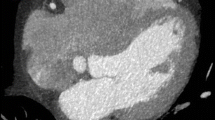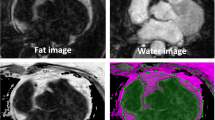Abstract
Purpose
The aim of this study was to assess a method for measuring epicardial fat volume (EFV) by means of a single-slice area measurement. We investigated the relation between a single-slice fat area measurement and total EFV.
Methods and methods
A series of 72 consecutive patients (ages 65 ± 11 years; 36 men) who had undergone cardiac computed tomography (CT) on a 64-slice multidetector scanner with prospective electrocardiographic triggering were retrospectively reviewed. Pixels in the pericardium with a density range from −230 to −30 Hounsfield units were considered fat, giving the per-slice epicardial fat area (EFA). The EFV was estimated by the summation of EFAs multiplied by the slice thickness. We investigated the relation between total EFV and each EFA.
Results
EFAs measured at several anatomical landmarks—right pulmonary artery, origins of the left main coronary artery, right coronary artery, coronary sinus—all correlated with the EFV (r = 0.77–0.92). The EFA at the LMCA level was highly reproducible and showed an excellent correlation with the EFV (r = 0.92).
Conclusion
The EFA is significantly correlated with the EFV. The EFA is a simple, quick method for representing the time-consuming EFV, which has been used as a predictive indicator of cardiovascular diseases.
Similar content being viewed by others
References
Nakamura T, Tokunaga K, Shimomura I, Nishida M, Yoshida S, Kotani K, et al. Contribution of visceral fat accumulation to the development of coronary artery disease in non-obese men. Atherosclerosis 1994;107:239–246.
Kobayashi H, Nakamura T, Miyaoka K, Nishida M, Funahashi T, Yamashita S, et al. Visceral fat accumulation contributes to insulin resistance, small-sized low-density lipoprotein, and progression of coronary artery disease in middle-aged non-obese Japanese men. Jpn Circ J 2001;65:193–199.
Miyawaki T, Abe M, Yahata K, Kajiyama N, Katsuma H, Saito N. Contribution of visceral fat accumulation to the risk factors for atherosclerosis in non-obese Japanese. Intern Med 2004;43:1138–1144.
Schoen RE, Thaete FL, Sankey SS, Weissfeld JL, Kuller LH. Sagittal diameter in comparison with single slice CT as a predictor of total visceral adipose tissue volume. Int J Obes Relat Metab Disord 1998;22:338–342.
Hayashi T, Boyko EJ, McNeely MJ, Leonetti DL, Kahn SE, Fujimoto WY. Visceral adiposity, not abdominal subcutaneous fat area, is associated with an increase in future insulin resistance in Japanese Americans. Diabetes 2008;57:1269–1275.
Rabkin SW. Epicardial fat: properties, function and relationship to obesity. Obes Rev 2007;8:253–261.
Sacks HS, Fain JN. Human epicardial adipose tissue: a review. Am Heart J 2007;153:907–917.
Iacobellis G, Assael F, Ribaudo MC, Zappaterreno A, Alessi G, Di Mario U, et al. Epicardial fat from echocardiography: a new method for visceral adipose tissue prediction. Obes Res 2003;11:304–310.
Dey D, Suzuki Y, Suzuki S, Ohba M, Slomka PJ, Polk D, et al. Automated quantitation of pericardiac fat from noncontrast CT. Invest Radiol 2008;43:145–153.
Wheeler GL, Shi R, Beck SR, Langefeld CD, Lenchik L, Wagenknecht LE, et al. Pericardial and visceral adipose tissues measured volumetrically with computed tomography are highly associated in type 2 diabetic families. Invest Radiol 2005;40:97–101.
Rubinshtein R, Halon DA, Gaspar T, Jaffe R, Karkabi B, Flugelman MY, et al. Usefulness of 64-slice cardiac computed tomographic angiography for diagnosing acute coronary syndromes and predicting clinical outcome in emergency department patients with chest pain of uncertain origin. Circulation 2007;115:1762–1768.
Chang SA, Choi SI, Choi EK, Kim HK, Jung JW, Chun EJ, et al. Usefulness of 64-slice multidetector computed tomography as an initial diagnostic approach in patients with acute chest pain. Am Heart J 2008;156:375–383.
Gorter PM, van Lindert AS, de Vos AM, Meijs MF, van der Graaf Y, Doevendans PA, et al. Quantification of epicardial and peri-coronary fat using cardiac computed tomography; reproducibility and relation with obesity and metabolic syndrome in patients suspected of coronary artery disease. Atherosclerosis 2008;197:896–903.
Sarin S, Wenger C, Marwaha A, Qureshi A, Go BD, Woomert CA, et al. Clinical significance of epicardial fat measured using cardiac multislice computed tomography. Am J Cardiol 2008;102:767–771.
Ueno K, Anzai T, Jinzaki M, Yamada M, Jo Y, Maekawa Y, et al. Increased epicardial fat volume quantified by 64-multidetector computed tomography is associated with coronary atherosclerosis and totally occlusive lesions. Circ J 2009;73:1927–1933.
Djaberi R, Schuijf JD, van Werkhoven JM, Nucifora G, Jukema JW, Bax JJ. Relation of epicardial adipose tissue to coronary atherosclerosis. Am J Cardiol 2008;102:1602–1607.
Gorter PM, de Vos AM, van der Graaf Y, Stella PR, Doevendans PA, Meijs MF, et al. Relation of epicardial and pericoronary fat to coronary atherosclerosis and coronary artery calcium in patients undergoing coronary angiography. Am J Cardiol 2008;102:380–385.
Taguchi R, Takasu J, Itani Y, Yamamoto R, Yokoyama R, Watanabe S, et al. Pericardial fat accumulation in men as a risk factor for coronary artery disease. Atherosclerosis 2001;157:203–209.
Author information
Authors and Affiliations
Corresponding author
About this article
Cite this article
Oyama, N., Goto, D., Ito, Y.M. et al. Single-slice epicardial fat area measurement: do we need to measure the total epicardial fat volume?. Jpn J Radiol 29, 104–109 (2011). https://doi.org/10.1007/s11604-010-0524-z
Received:
Accepted:
Published:
Issue Date:
DOI: https://doi.org/10.1007/s11604-010-0524-z




